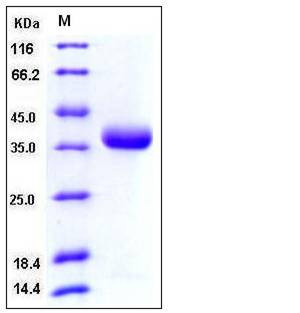Human PRLR / Prolactin Receptor Protein (His Tag)
HPRL,hPRLrI,MFAB,PRLR
- 100ug (NPP4192) Please inquiry
| Catalog Number | P10278-H08H |
|---|---|
| Organism Species | Human |
| Host | Human Cells |
| Synonyms | HPRL,hPRLrI,MFAB,PRLR |
| Molecular Weight | The recombinant mature human PRLR consists of 221 amino acids after proteolytic removal of the signal peptide and predicts a molecular mass of 26 kDa. By SDS-PAGE under reducing conditions, it migrates as an approximately 36-38 kDa band due to glycosylation. |
| predicted N | Gln 25 |
| SDS-PAGE |  |
| Purity | > 98 % as determined by SDS-PAGE |
| Protein Construction | A DNA sequence encoding the extracellular domain of human PRLR (NP_000940.1) (Met 1-Asp 234) was fused with a polyhistidine tag at the C-terminus. |
| Bio-activity | |
| Research Area | Immunology |Signal Transduction |Other Related Intracellular Topics |Cellular Senescence and Pathways in Aging |Growth Hormone/IGF-I Axis |
| Formulation | Lyophilized from sterile PBS, pH 7.4 1. Normally 5 % - 8 % trehalose, mannitol and 0.01% Tween80 are added as protectants before lyophilization. Specific concentrations are included in the hardcopy of COA. |
| Background | Prolactin receptor (PRLR) is a single-pass transmembrane receptor belonging to the type â… cytokine receptor superfamily, and contains two fibronectin type-â…¢ domains. All class 1 ligands activate their respective receptors by clustering mechanisms. Ligand binding results in the transmembrane PRLR dimerization, followed by phosphorylation and activation of the molecules invloved in the signaling pathways, such as Jak-STAT, Ras/Raf/MAPK. The PRLR contains no intrinsic tyrosine kinase cytoplasmic domain but associates with a cytoplasmic tyrosine kinase, JAK2. PRLR mainly serves as the receptor for the pituitary hormone prolactin (PRL), a secreted hormone that affects reproduction and homeostasis in vertebrates. PRLR can be regulated by an interplay of two different mechanisms, PRL or ovarian steroid hormones independently or in combination in a tissue-specific manner. The role of the hormone prolactin (PRL) in the pathogenesis of breast cancer is mediated by its cognate receptor (PRLR). Ubiquitin-dependent degradation of the PRLR that negatively regulates PRL signaling is triggered by PRL-mediated phosphorylation of PRLR on Ser349 followed by the recruitment of the beta-transducin repeats-containing protein (beta-TrCP) ubiquitin-protein isopeptide ligase. which altered PRLR stability may directly influence the pathogenesis of breast cancer. |
| Reference |
